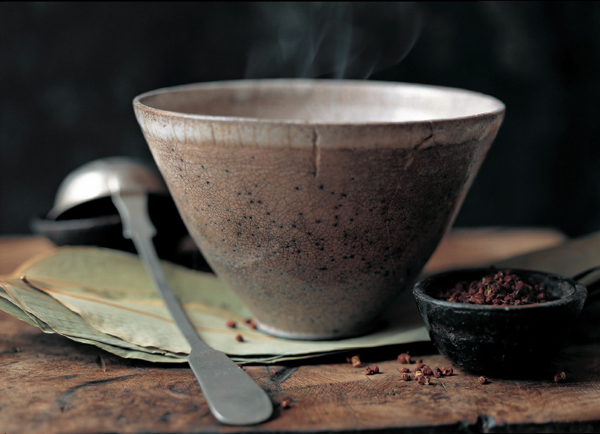

“Mongol moto”: a motorcycle tailored for cold weather with fur-muffed handlebars, in Hailar, Inner Mongolia.
Many of the dishes in this chapter, notably the ones from cold-weather climates, are like Central Asian cousins of the traditional soups, broths, and stews of northern and eastern Europe (Irish stew, for example) and the related pioneer dishes of North America. They are made with potatoes and carrots, a touch of greens when available, and meat for depth of flavor. Cooking is often in one pot and involves long, slow simmering of meat, bones, and vegetables.
The broths give wonderful flavor to other dishes: hot pots, noodle dishes, soups, and stews. And the soups are distinctive, from Tsampa Soup (page 47), with its seductive flavor of roasted grain and its smooth texture, to the delicate balance of tomato and lamb in Hui Tomato-Lamb Noodle Soup (page 59), to the hearty and satisfying Hui Vegetable Soup (page 48), made with no meat at all.
There are recipes here as well from the subtropical hills and valleys of southern Yunnan and Guizhou, where soup is at the heart of the family meal, eaten with rice and an assortment of other dishes, often stir-fries. Even in these milder climates, people turn to soup for comfort and sustenance. The soups are quickly made and have a wonderful inventiveness; see Family Soup Dong-Style (page 49) and Dai Chile-Fish Soup with Flavored Oil (page 54).
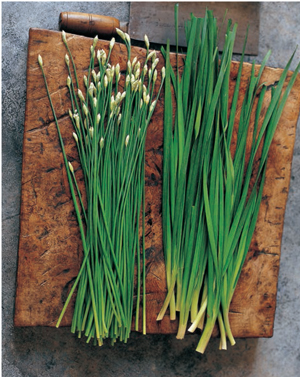
Chinese chives: chive flowers (buds) on the left and chives with flat leaves only (also called garlic chives) on the right.
This is so simple it’s hardly a recipe, but it was new to us. In the Altai Mountains in northern Xinjiang, I was invited several times into a Kazakh yurt, where, sitting on carpets and leaning against padded quilts, I watched as meals were cooked over a small portable iron stove fueled with wood. The meals were some of the simplest and best I have ever eaten, often prepared with just a pressure cooker.
Goat shank was simmered in the cooker to make a broth, and while it was cooking, a noodle dough was rolled out (see Kazakh Noodles, page 133). When the broth was ready, the steam was released from the pressure cooker and the meat taken out of the pot, leaving the hot broth on top of the stove. The noodles were then stretched by hand and dropped into the hot broth. It all happened quickly and deftly and looked effortless, with people chatting all the while.
I came home from northern Xinjiang determined to buy a pressure cooker. But in the end, we just cooked the goat shanks in a large soup pot. It was so easy, and so good.
We’ve come to love goat as a less expensive and very delicious alternative to lamb. Good goat meat, from a reasonably young animal, has a mild lamb flavor. It is becoming more available in North America, and we recommend it highly; look for organic or naturally raised meat (see Glossary for more).
Serve the broth as a clear soup, or use it the traditional way to cook Kazakh Noodles or other homemade or store-bought noodles. Then serve the noodles in the broth, or serve the broth as a side dish to a platter of the noodles, as you please.
1½ pounds goat shank or lamb shank, cut into 1-inch lengths (have the butcher do this)
4 quarts cold water
Salt
Place a cast-iron or other heavy 8-quart pot over low heat. Add the pieces of shank to the dry pot and brown all over, turning occasionally, approximately 15 minutes.
Add the water and raise the heat to bring it to a vigorous boil, then lower the heat and simmer, partially covered, for about 2 hours.
Remove the bones and meat from the broth. Cut the meat into bite-size pieces and put out on a plate, so guests can add it to their soup as they wish. Add salt to taste to the broth (we normally start with ½ teaspoon salt for 2 cups broth), and ladle into bowls.
Makes about 8 cups broth; serves 8 as a clear soup, 4 to 6 as a one-dish meal with noodles
A Tibetan man drives a small tractor in the center of Litang, a large Tibetan town in western Sichuan.
This useful broth is called ruthang in Tibetan. It’s traditionally made by simmering yak bones, for which we substitute oxtail or beef shank, It gives many Tibetan recipes great depth of flavor (see, for example, Tsampa Soup, page 47, and Stir-Fried Stem Lettuce Lhasa-Style, page 103), and we find ourselves happy to always have a stash of it in the freezer, especially in the colder months of the year.
2 pounds oxtail or bone-in beef shank, chopped into 8 to 12 pieces (have the butcher do this)
About 9 cups water
1 tablespoon minced or crushed ginger
1 star anise (optional)
1 teaspoon salt
Rinse the beef thoroughly in several changes of lukewarm water. Place in a large heavy pot and add enough cold water to cover by an inch or two. Bring to a boil and skim off the foam. Add the ginger, star anise, if using, and salt, reduce the heat, and simmer, partly covered, for 1 hour.
Pour the broth through a sieve or strainer into a bowl. (Set the bones and meat aside if you wish, to be served with rice or noodles, or discard them.) If not using the broth immediately, let it cool completely, then store it in a well-sealed container in the refrigerator, or freeze in 2-cup containers.
Makes about 8 cups
Tsampa Soup
There is something very soothing and sustaining about tsam-thuk, as this classic soup is called in Lhasa dialect. It is another take on the freshly-baked-bread-with-meat idea that characterizes the food of central Asia (and, in fact, much of the traditional cooking of northern Europe as well). Here, instead of flatbreads wrapped around fire-cooked kebabs, the meal is soup, a beef broth thickened with tsampa, the roasted barley ground into flour that is a Tibetan staple. There’s a seductive taste, almost nutty, from the roasted grain, and a smoothness on the tongue from the blend of tsampa and the butter added at the last moment. “Shin-bu-du! (Delicious!)”
This is a Lhasa version, made with strips of steak that we substitute for the traditional yak meat. In other more rural places, where fresh meat is not often available, cooks would usually include small pieces of dried yak meat.
1¼ cups Tsampa (page 180), or substitute 1 cup barley flour, dry-roasted in a skillet until golden
¼ pound daikon radish (about ½ small radish)
6 cups Tibetan Bone Broth (page 45) or beef or chicken broth
2 tablespoons peanut oil, vegetable oil, or butter
½ medium onion, thinly sliced
½ to ¾ pound boneless beef round or sirloin steak, cut into strips about 1½ to 2 inches long and ¼ inch wide
2 to 3 cups water
2 to 2½ teaspoons salt, or to taste (see Note)
1½ to 2 cups baby spinach leaves or coarsely chopped regular spinach
2 tablespoons butter
To make sure your tsampa or roasted flour is fine enough, pass it through a fine sieve. Set aside.
Peel the daikon radish, then grate it on a coarse grater into long strands. Set aside.
Pour 3 cups of the broth into a wide heavy pot (4 quarts is a good size) and bring to a boil. Add the tsampa or roasted flour and stir until smooth. Add the remaining 3 cups broth and bring to a boil. Add the radish strands and simmer until tender, about 10 minutes.
Meanwhile, heat the oil or butter in a heavy skillet over medium heat. Add the onion and sauté gently for several minutes. Add the meat strips and ½ teaspoon salt, raise the heat to medium-high, and cook, turning once, just until the beef has changed color, about 3 minutes total. Use tongs to lift out the meat and set it aside on a plate. Add the onion and oil or butter to the soup.
To deglaze the skillet, place the pan over high heat, add 1 cup water, and bring to a boil. Scrape the bottom of the pan with a spatula to detach any browned bits or caramelized juices, then add the flavored water to the soup. (The recipe can be prepared ahead to this point and set aside for up to 1 hour. Or let cool, and refrigerate for up to 36 hours. Bring the soup to a simmer before proceeding.)
Add 1 cup more water to the soup and bring back to a simmer. Add the meat and bring back to a simmer. Add extra water if you wish a thinner broth. Taste for salt and add up to 2 more teaspoons if necessary. Add the spinach leaves to the simmering broth. When they turn bright green, after a minute or two, add the butter and stir to blend it in.
Serve the soup hot in large bowls, with bread, or with rice if you prefer.
Serves 4 or 5 as a main course, 6 to 8 as a soup course
NOTE ON SEASONING: A number of recipes in Lhasa cooking use soy sauce. These tend to be wealthy people’s versions of traditional dishes. People in the country, or those with less money, would usually not include city refinements, such as soy sauce and a greater variety of vegetables. If you’d like, instead of using salt to adjust the seasoning, add 1 to 2 tablespoons soy sauce; it gives an extra depth of flavor.
I learned this easy soup at a tiny hole-in-the wall eatery in a town called Labrang in Tibetan, Xiahe in Chinese, in the southern part of Gansu province. The town is home to a huge Tibetan monastery, also called Labrang, and is surrounded by hilly grasslands. Apart from the majority Tibetan population, there are a large number of Hui people (see page 216).
Three people ran the little eatery: a Hui brother and sister, and the brother’s wife, who was about six months pregnant. I watched her early one morning as she prepared the vegetable soup that they would be using all day. It can be served as a hearty cabbage and potato soup or strained and used as a broth or wonderful all-purpose stock, or as the liquid in a vegetarian hot pot. The Hui café owners serve it as a broth over noodles.
The basic flavor and nutrition come from tofu sticks (available in Asian groceries; see the Glossary for more about these useful pantry staples). They’re soaked briefly in water to soften, then chopped and stir-fried. The other essentials include a couple of potatoes, peeled and sliced, and plenty of grated or thinly sliced cabbage.
This simple dish is easy to make if you have the right tools: a good sharp cleaver or chef’s knife (we prefer a cleaver here) and a heavy stockpot.
A generous handful of tofu sticks (6 or 7 lengths of about 8 inches; see headnote)
¼ cup peanut oil or vegetable oil
1 tablespoon minced ginger
2 teaspoons salt, or to taste
¼ teaspoon Sichuan peppercorns, ground
½ teaspoon cumin seeds, ground, or ground cumin
¾ pound (2 medium-large) Yukon Gold potatoes or red potatoes, peeled and thinly sliced
About ½ pound Napa cabbage (½ small cabbage), thinly sliced crosswise (4 cups loosely packed)
About 6 cups water
1 teaspoon Guizhou Chile Paste (page 35), Bright Red Chile Paste (page 18), or store-bought chile paste
2 cups loosely packed coarsely torn spinach leaves or chopped greens such as amaranth leaves, pea tendrils, or dandelion greens
Place the tofu sticks in a large wide bowl, add warm water to cover, and let soak for 15 minutes. Drain, squeeze out the excess water, and chop the sticks into 2-inch lengths. You should have about 1½ cups. Set aside.
Heat the oil in a medium heavy stockpot (about 6 quarts) over medium-high to medium heat. Add the tofu sticks and stir-fry for 2 minutes (if they start sticking, lower the heat a little). Add the ginger, salt, Sichuan pepper, and cumin and stir well. Add the potato slices and cabbage. Cook, stirring and turning the vegetables to expose all surfaces to the flavored oil and the heat, for several minutes, until you see the cabbage starting to wilt a little.
Add 2 cups water and the chile paste and stir to mix. Bring to a boil, cover, and cook at a gentle boil until the vegetables are very soft, about 10 minutes. Add about 4 more cups water and bring to a boil. Cover, reduce the heat, and simmer for 10 minutes. (The soup will look like a fairly thick cabbage soup at this point.)
Add the spinach or other greens and cook, stirring occasionally, just until tender.
Ladle into bowls and serve, perhaps with hunks of bread and some cheese, Western-style.
Serves 4 as a one-dish meal
HUI VEGETARIAN BROTH: Cook the soup for an extra 20 minutes, without adding the greens, then strain it, discarding the solids. Serve as a clear broth, with some greens floating in it if you wish, or use as an ingredient in stir-fries or other dishes. Or dilute it with more water to use as the cooking broth for Hui Vegetable Hot Pot (page 117).
At family suppers in Dong culture (see page 120), the soup goes in the center of the table, with a hot charcoal fire under it to keep it bubbling. The round table has a hole cut in the center to accommodate the pot, which has a rounded bottom and looks like a deep wok. A ladle is set out, and diners use it to scoop some soup into their bowl of rice. Then, using their chopsticks, they help themselves to a bite or two from another dish—say, a stir-fried vegetable or slices of grilled meat.
We like to serve this in a heavy pot that holds the heat. Another option would be to place the soup in a hot pot (see page 269) or an electric rice cooker (as I saw done in a less traditional Dong household), or in a pot over a small portable stove at the table. Put out a ladle so guests can help themselves to broth now and then throughout the meal. Apart from rice, we’d suggest serving a side with some crisp texture, such as Jicama–Tofu Sheet Stir-Fry (page 105) or Green Papaya Salad with Chiles (page 78), as well as a simple grilled meat or fish dish, such as Grilled Pickerel from Burqin (page 228) or Mongolian Lamb Patties (page 272).
2 tablespoons peanut oil
3 dried red chiles
2 tablespoons minced ginger
1 tablespoon minced garlic
½ teaspoon Sichuan peppercorns, coarsely ground
½ pound boneless pork shoulder or butt or fresh ham, thinly sliced and cut into pieces approximately 1½ inches by 1 inch
4 cups water
1 teaspoon salt, or to taste
2 tablespoons minced scallion greens or chives (optional)
Heat a large wok or heavy skillet over high heat. Add the oil and swirl gently to coat the pan. Toss in the chiles, ginger, garlic, and Sichuan pepper and stir-fry for 5 to 10 seconds. Add the meat and stir-fry to expose all surfaces to the hot pan until all surfaces have changed color. Add the water and salt and bring to a boil. Reduce the heat and simmer, partially covered, for 10 minutes.
Just before serving, add the scallion greens or chives and simmer just until wilted. Taste for salt and adjust if necessary. Serve hot.
Serves 4 with rice and one or two side dishes
NOTE: When I watched this soup being made in a Dong household, the cook added the water to the stir-fried seasonings, and then the pork went into the boiling water. We prefer to stir-fry the pork slices first, to sear them and give them more flavor, then add the water and simmer.
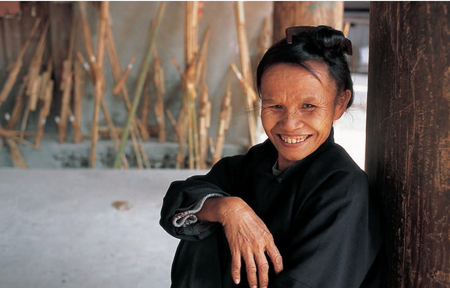
A Dong woman sits under a drum tower in Zhaoxing, a large Dong village in eastern Guizhou. In the background, the neighborhood’s lusheng (large panpipe-like instruments) are leaning against a wall. Dong drum towers, tall pagoda-like structures made of fir and constructed without nails, are gathering places where children play and older people meet to chat. There are usually wide comfortable wooden benches under the towers, where women work on their embroidery while men play some form of chess or checkers.
On the bank of the Yarlung Tsangpo (the Tibetan name for the Brahmaputra River), a Tibetan man waits in a sandstorm, spinning his prayer wheel. Samye Gompa, the first Buddhist temple in Tibet (built over 1,100 years ago) and a place of pilgrimage, is four hours walk away. The Tsangpo rises by Mount Kailas, the sacred mountain in western Tibet, and then flows due east for about 800 miles before turning south through the Himalaya and flowing into India and Bangladesh.
I reached Lhasa for the first time in March 1985. I had flown from Chengdu, in Sichuan, on a very early flight. I remember arriving at the airport hours before dawn, nervous that somehow the flight wouldn’t happen. I had my ticket, I even had a special permit for Tibet issued by the Public Security Bureau (a branch of the police), but somehow I thought I’d get stopped: I’d wanted to go to Tibet for as long as I could remember, and had never thought it would be possible. Tibet had been absolutely “closed” all my life, and for all my parents’ lives. Several times while in Nepal, I’d trekked near the border, Tibet feeling like a wild, vast unknown on the other side of the mountains.
There were a couple of other Westerners in the queue, but the flight was almost entirely military, PLA (People’s Liberation Army). I had no idea why the Beijing government had opened Tibet to foreigners.
At dawn the plane took off, and almost immediately we were over mountains. As far as I could see, there were mountains covered in snow. The mountains were incredibly high, and the narrow valleys amazingly deep. The plane kept heading west, crossing one ridge of mountains, then a cleft of valley, then another ridge of mountains, one after the next. It was like nothing I had ever seen before (or anywhere else since).
We arrived at Gonggar Airport, south of Lhasa, in midmorning. We walked over from the plane to a one-room concrete-block building, the terminal, to pick up our bags. The sun was bright and harsh (at 11,000 feet above sea level), and the wind was cold. I could see for miles in all directions, and there was barely a tree on the landscape. There wasn’t a bus or a car in sight. I slept that night in a simple hotel near the airport. The next day a bus appeared and a couple of hours later I was in Lhasa.
I stayed in the dormitory of the Banak Shol Hotel, one of two hotels in Lhasa at that time. There was a restaurant on the ground floor. To order, I’d go into the kitchen and point to ingredients that I wanted, and then a cook would stir-fry them in a large wok set over a roaring wood fire. Stir-fry and rice—the selection wasn’t much, but it was hot and good.
After a week or so in Lhasa, I felt as if I knew almost every foreigner in town, at least by sight. There weren’t many of us. Everyone exchanged information, because we were all equally ignorant. There were no guidebooks, no local maps. At last someone found a Bank of China office in a tiny house far from the city center, where we could change money, and a sigh of relief went through the hotel.
Lhasa was a bit surreal for me then, and raw. The cold wind blew constantly. My traveling companion, a woman, was assaulted at knifepoint by a Tibetan man. Some of the foreigners in the hotel didn’t believe her; they didn’t want to know anything bad about Tibet. Tibet was tough, no doubt about it.
It was also extraordinarily full of life. People laughed and joked, and at night they’d eat, drink, sing, and dance. In the market, Tibetans would pull at the hair on my arms and then giggle, or a stranger might give me a piece of dried cheese just to be friendly. Having come from central China, where I’d grown accustomed to suspicious or sullen-looking faces, I was suddenly in a place where people happily engaged with me, where people were more apt to smile than to stare. J
In 1979, long before I ever traveled to China, I sat in on a sociology of China class at the University of Pittsburgh taught by Professor C. K. Yang, a wonderful teacher. The reading list was huge, and it was such great reading, I read every word.
But I am often reminded that much of what we read I later discovered to be relatively untrue. For example, the Cultural Revolution (1966–1976) had been over for several years when I took the course. We now know that it was a terribly destructive time in China, yet the only book we read about it described it positively, as a recharging of the batteries of revolution. Academics in the West, including Professor Yang, remained determined to see China through rose-tinted glasses, and in part for good reason. China had, after all, made a remarkable transition from the utter depths of poverty, although at a price.
Now, in the twenty-first century, I wonder if we in the West are again sometimes deliberately blind when it comes to China, only this time it’s not the academics, but the business world. China is a totalitarian state with a terrible human rights record, but it’s also an enormous market. Perhaps Western business interests, like the Western academics of the 1960s and ’70s, see only the parts of China they want to see. J
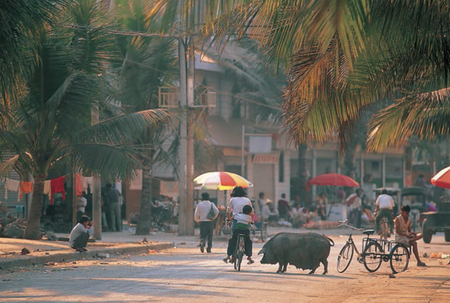
A subtropical streetscape in southern Yunnan, in the town of Menghan.
Dai Chile-Fish Soup with Flavored Oil
Behind most Dai houses in the villages of southern Yunnan, there’s a small pond. Fish live there, and when the cook wants fresh fish, she can just go to the pond and scoop one out, or send a child to get one for her. As a result, there’s a large Dai repertoire of dishes using fresh fish.
This is one of the easiest soups we know, a pleasure whether served as a fish course in a Western-style meal or as one of several dishes in a rice-centered Southeast Asian–style meal. It reminds us of the fish soups from farther south in the Mekong Valley, in Laos and Cambodia. As in those soups, there is acidity, in this case from tomato, and coriander leaves are used to flavor the broth rather than simply as a garnish.
The soup has a fair amount of chile heat. To cut back on it, reduce the number of chiles. The secret ingredient is the Dai Flavored Oil, which tempers the soup, bringing flavors together. Assemble the ingredients for the oil before you start the broth. That way, you can quickly make the oil while the broth is cooking, then add it to the soup, hot and aromatic, straight from the pan.
1¼ to 1½ pounds firm-fleshed fish steaks or fillets, such as tilapia, striped bass, or lake trout, or an ocean fish such as snapper or cod
4 cups water
3 dried red chiles
2 fresh green bird chiles or serrano chiles
1 tablespoon ginger, cut into small matchsticks
1 garlic clove, smashed
1 large or 2 small scallions, sliced lengthwise into ribbons, then crosswise into 2-inch lengths
1 cup coriander leaves and stems, coarsely chopped
1 medium tomato, ripe or green, as you wish, finely chopped
2 tablespoons Dai Flavored Oil (page 55), or to taste
1½ to 2 teaspoons salt, or to taste
Freshly ground pepper (see Note on Pepper)
Cut the fish into 1- to 2-inch pieces. Place in a small pot, add the water, whole chiles, ginger, garlic, scallions, and coriander, and bring to a boil, then immediately lower the heat and simmer for 5 minutes.
(Meanwhile, prepare the flavored oil.)
Add the tomato, the oil, including the garlic slices, and 1½ teaspoons salt to the hot broth and simmer for another 5 minutes or so. Taste for salt and adjust if necessary, then add pepper to taste.
Serve hot or warm.
Serves 4 as a soup course or as part of a rice meal
NOTE ON SERVING: The soup is traditionally served with all the flavorings still in it. The chiles and garlic clove are not meant to be eaten, but are just put aside by each diner as he or she eats. If you wish, you can strain the soup before serving it, so that it comes to the table as a broth. In that case, though, we’d suggest that you remove the garlic slices from the flavored oil before adding it to the soup and set them aside, then add them to the broth when you serve it.
NOTE ON PEPPER: Both white and black pepper are used in Southeast Asian cooking. White tends to be used in pale dishes such as this, partly for aesthetic reasons. But we find we always prefer the rich taste of black pepper to that of white; suit yourself.
WHOLE FISH OPTION: We suggest that you use fish steaks or fillets, but you could start with a whole fish weighing close to 2 pounds. Trim off the head and fins, lift the meat off the bone, and cut it into 1- to 2-inch pieces. Then simmer the trimmings and bones in 3 cups water, and use the strained broth as part of the liquid for the soup.
Flavored oils are the cook’s best friend. In Southeast Asia, these oils—others include scallion oil, chile oil (see page 29), garlic oil, and combinations thereof—are added at the last moment, just before the dish is served. Sometimes they are floated on the surface of a soup when it is served, as olive oil or butter might be on a Mediterranean or European soup, to give a subtle extra richness. Other times, as in this soup, they are added near the end of cooking to pull all the flavors together and accentuate them. Try adding this oil at the last minute to other soups to give them another layer of flavor and heat.
2 tablespoons peanut oil or vegetable oil
4 dried red chiles
1 tablespoon thinly sliced garlic
Heat the oil in a small heavy skillet. When it is hot, toss in the chiles and garlic and wait several seconds, until they start to brown, then remove from the heat and remove the chiles. Add the oil and garlic to the hot soup, or put out as a table condiment.
Makes a generous 2 tablespoons
NOTE ON SCALING UP: To multiply the recipe, increase the oil and garlic in the same proportion, but the chiles by less than half as much again. For example, to triple the recipe, use 6 tablespoons oil, 3 tablespoons sliced garlic, and only 6 to 8 chiles.
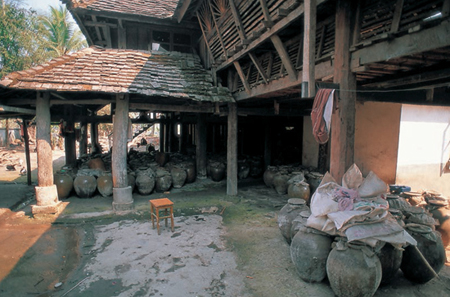
Earthenware containers of rice liquor and pickled vegetables are stored under traditional Dai houses in southern Yunnan.
Dried noodles for the pantry: on the left and right, two versions of cellophane noodles (bean threads) tied with the traditional twine; and in the middle, an opened bundle of rice sticks (dried rice noodles).
This delicate soup was served at a party, a sit-down banquet for about eighty people that I was invited to in the Dong village of Zhaoxing in eastern Guizhou province. It may look a bit demanding because of the fish balls, but it is surprisingly easy to put together.
You can buy fish balls, fresh or frozen, in most Chinese and Southeast Asian grocery stores, but homemade ones are quick to make and usually better. Start with fish fillets from any white-fleshed fish you like. You can also begin with a whole fish, in which case you’ll want one that weighs 2 pounds or a bit more. Use the trimmings to make your broth.
Cellophane noodles are also known as bean threads. They’re manufactured from a paste made of processed mung beans that is extruded as very thin noodle strands. They are sold dried, in small cellophane packages weighing 100 grams (less than 4 ounces) or in larger ones weighing 500 grams (about 1 pound). Cellophane noodles must be soaked briefly in hot water before they can be cut into lengths and cooked. When cooked, they are tender and transparent.
SOUP
6 cups water
2 scallions, minced
1 tablespoon minced ginger
About ½ pound fish heads and/or bones or fish steaks or fillets
¾ teaspoon salt, or salt to taste
Half a 100-gram package cellophane noodles (use sharp kitchen scissors to separate the noodles from the larger bundle)
1 teaspoon rice vinegar
1 teaspoon roasted sesame oil
About ¼ cup chopped Chinese celery leaves or coriander leaves (optional)
1 pound boneless, white-fleshed skinless fish fillets (see headnote)
½ teaspoon minced ginger
½ teaspoon cornstarch
¼ teaspoon salt
Up to ¼ cup water
To make the broth, place the water in a medium pot, add the scallions, ginger, and fish heads and bones, and bring to a vigorous boil. Add the salt, partially cover, and cook at a strong boil for 20 minutes. Lower the heat, cover, and simmer for another half hour or so.
Meanwhile, place the bean threads in a bowl and add hot water to cover. Let soak for 15 to 20 minutes, then drain. Use scissors to cut them into shorter lengths if you wish. Set aside.
To make the fish balls, use a cleaver or sharp knife to finely chop the fish, or pulse in a food processor. Place in a medium bowl, add the minced ginger, cornstarch, and salt, and use your fingers or a fork to mix and blend well. Add 2 tablespoons water and mix well. Scoop up about 1 teaspoon of the mixture and try to press it into a ball. If it is too crumbly to stick together, add a little more water (some fish require a little more or a little less water than others) and squeeze the mixture between your fingers to blend it.
Lightly oil a plate. With moist hands, shape a fish ball by scooping up a scant tablespoon of the fish mixture and lightly rolling it into a ball between your moistened or lightly oiled palms. Set the ball on the plate. It will be a little bumpy perhaps, especially if you hand-chopped the fish; don’t worry. Repeat with the remaining fish mixture. You will have 30 to 35 balls. Set aside.
Strain the fish broth through a fine-mesh sieve and discard the solids. You should have between 3 and 4 cups broth. Add water if necessary to bring it up to 4 cups. Pour the broth back into the pot, add the vinegar, and taste for salt. Adjust the seasoning if you wish.
About 10 minutes before you wish to serve the soup, bring the broth to a rapid boil. Add the soaked bean threads and the fish balls and bring to a boil. Reduce the heat slightly and cook at a strong simmer for 5 to 7 minutes, or until the fish balls are cooked through; use a slotted or mesh spoon to turn the balls over so all sides are exposed to the hot broth. They will turn white and expand a little as they cook.
Remove from the heat, add the sesame oil, and serve immediately, topped with a sprinkling of celery leaves or coriander leaves if you wish. Put out the pot or a large serving bowl of the soup, with a ladle and tongs or chopsticks, so guests can help themselves. Or serve in individual bowls, allotting about 5 to 6 fish balls to each, as well as noodles and broth, and top each with several leaves of celery or coriander if you wish.
Serves 4 generously as a soup course, 6 as part of a rice meal
A line of chortens (the Tibetan word for stupa) outside Kumbum Monastery. Kumbum lies a short distance south of the town of Xining, in Qinghai province, and is an important center of pilgrimage. It is here that the present Dalai Lama was first taken as a child—after he was recognized as the reincarnation of the preceding (thirteenth) Dalai Lama—for his family home is in a nearby village.
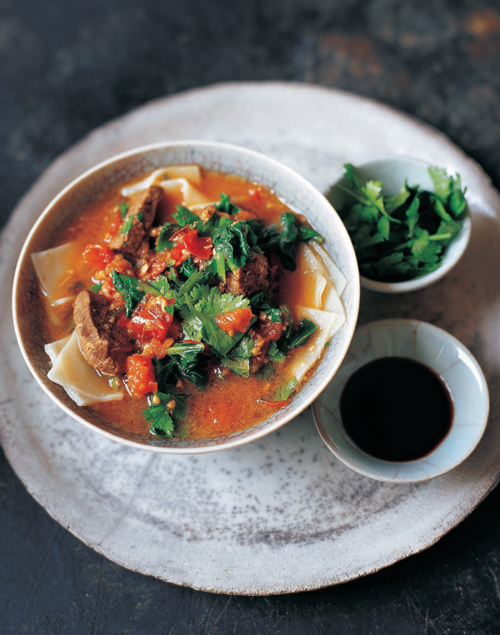
Hui Tomato-Lamb Noodle Soup
I’m in Rekong, a small town in Qinghai, tired from the journey here and wanting only to send a quick e-mail, eat a warm meal, and sleep a long sleep. I ask at my little hotel for directions to the wan-ba, as e-mail places are known in China. And there it is, just along from where I’m staying, crowded with young people and thick with cigarette smoke. When I’m finished, and paying for my half hour, I ask the guy at the cash register where to eat. He sends me down the street to a little Hui restaurant that’s steamy with the aromas of hot soup and noodles. I sit at a table and soon a huge bowl arrives, a tomato-lamb broth with small tender pieces of lamb and tomato floating in it, served over slippery square-cut noodles. It’s completely delicious and satisfying, a warm welcome on a chilly rainy evening.
Dough for Amdo Noodle Squares (page 128), or substitute ¾ pound store-bought wide egg noodles cut into 2- to 3-inch lengths
2 tablespoons peanut oil, vegetable oil, or rendered lamb fat (see Glossary)
1 tablespoon minced ginger
1 tablespoon minced garlic
¾ pound lamb or goat meat, trimmed of fat and cut into bite-sized pieces (about 1½ cups)
½ to 1 teaspoon salt, or to taste
2 medium tomatoes, chopped (about 1½ cups)
5 cups hot water
1 cup packed coarsely chopped spinach or other greens (see Note)
About ¾ cup minced coriander
CONDIMENTS
Jinjiang (black rice) vinegar, cider vinegar, or rice vinegar
Soy sauce (optional)
Make the noodle dough, if using, and set aside to rest, covered with plastic wrap.
Heat the oil or fat in a large heavy pot over medium heat. When it is hot, add the ginger and garlic and cook, stirring occasionally, until softened, about 5 minutes. Add the meat, raise the heat to medium-high, and brown it all over. Stir in ½ teaspoon salt, then add the tomatoes. Lower the heat to medium and cook, stirring occasionally, for 5 minutes.
Add the hot water and bring to a vigorous boil, then lower the heat and simmer, partially covered, for 10 minutes. Taste for salt, and adjust if you wish. Remove from the heat. (The soup can be prepared ahead and reheated just before serving. Refrigerate, covered, if not serving within 1 hour.)
Shortly before you wish to serve the soup, bring a large pot of salted water to a boil. If you made the dough, roll out and cut the noodles. Cook the noodles until tender; drain.
Meanwhile, bring the soup to a boil. Stir in the spinach and let cook for 1 minute, or until softened.
Divide the noodles among four large bowls. Ladle the hot soup over the noodles, distributing the meat, spinach, and tomatoes evenly as you do so. Top each serving with a generous tablespoon of minced coriander.
Put out the remaining coriander along with the other condiments so guests can adjust their soup to taste. Encourage them to drizzle a little vinegar into their soup, or put out a small condiment bowl for each guest, so they can make a dip of vinegar and soy to use as a flavoring for the pieces of meat as they eat.
Serves 4 as a one-dish meal
NOTE ON GREENS: You can substitute chard leaves, stripped from the stems, or other tender leafy greens for the spinach; cooking time will be a little longer for chard than for spinach. Or you can omit the greens entirely.

As is the case with Tibet, the ethnographic and cultural borders of Mongolia are larger than the present-day political borders of the country of Mongolia (also known as Outer Mongolia) and the Chinese province of Inner Mongolia. Ethnographic Mongolia extends both farther north, into Siberia, and farther south and west, to the Great Wall and into Xinjiang province. If you also include the many pockets of Mongols who have survived even farther afield, as far west as Afghanistan and as far south as Yunnan province, then the Mongolian “world” is a very large one.
The Mongols were once a force that conquered China, most of Central Asia, and beyond (see page 7), but they were driven out of central China in the fourteenth century and largely returned to their homeland. They continued to form alliances but were never again a great power.
There are approximately five million Mongols in China today, almost four million of them in Inner Mongolia. They make up less than 20 percent of the population of the province; the Han majority there numbers about twenty million. Inner Mongolia became a political part of China in the twentieth century, though it remained (and remains today) culturally linked to the People’s Republic of Mongolia through shared customs, language, and religion.
The Mongols converted to the Tibetan form of Buddhism at the time of Kublai Khan. Oboos (stones piled into cairns) topped with prayer flags mark significant places in the landscape in Inner Mongolia and the temples are very like Tibetan temples (see photo, page 268). Mongol pilgrims visit temples in Lhasa and other significant Tibetan Buddhist temples on pilgrimage.
The Mongols in Inner Mongolia today can be roughly divided into three groups. One is still semi-nomadic, living relatively traditionally, keeping herds of sheep and goats, cattle and horses (see “Mongolia out of Season,” page 244). Their dome-shaped dwellings, built on light wooden frames, are called gers, though outsiders often refer to them as yurts, the Turkic name. Another group, a relatively small one, is also rural but is engaged in cultivation rather than raising animals. However, most farming in Inner Mongolia is done by Han people whose parents and grandparents settled there. They grow grain (barley, millet, buckwheat, and corn), as well as hardy vegetables such as cabbage and root vegetables. The third group consists of Mongols who work in mining, or in industry or other urban occupations, and live in cities and towns such as the capital, Hohhot, and the industrial city of Baotou.
In Mongol tradition, foods are categorized into white foods (eaten more in the summer and fall) and red foods (more associated with cold weather). White foods are milk and dairy products, processed or dried or fermented, including various forms of yogurt, dried milk strips, cheese, and more. (Settled Mongols traditionally eat more grain, such as parched barley, and hardy vegetables, in place of the white foods of nomadic animal herders.) Red foods are, of course, meat, mostly sheep, usually simmered, then eaten with the broth that results. Traditionally all parts of the animal are eaten. Tea is a staple, drunk with milk, sometimes with butter and salt added too.
Inside a Mongol ger: the smoke-hole flap is partly open, letting in light, there’s a kettle on the wood stove, and Saren (see “Mongolia out of Season,” page 244) carries a large thermos of tea. Beds are placed against the walls and stacked with folded quilted bedding.
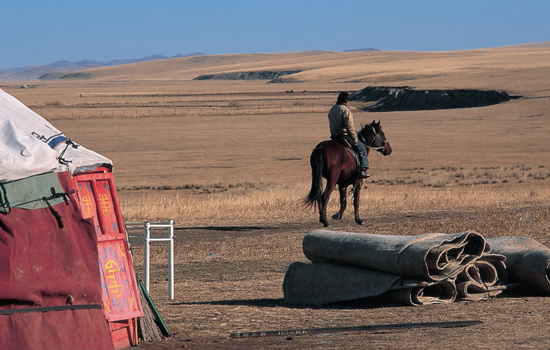
A horseman rides across the Hulun Buir Plain in late October, the season when Mongol herders move their gers (yurts) from up on the hills to campsites in the valley near the river. The ger is made of canvas and felt lashed to a dome-shaped wooden frame, where the one entrance, a painted wooden door, is set. On the ground, rolls of folded felt and canvas lie ready to cover another ger.